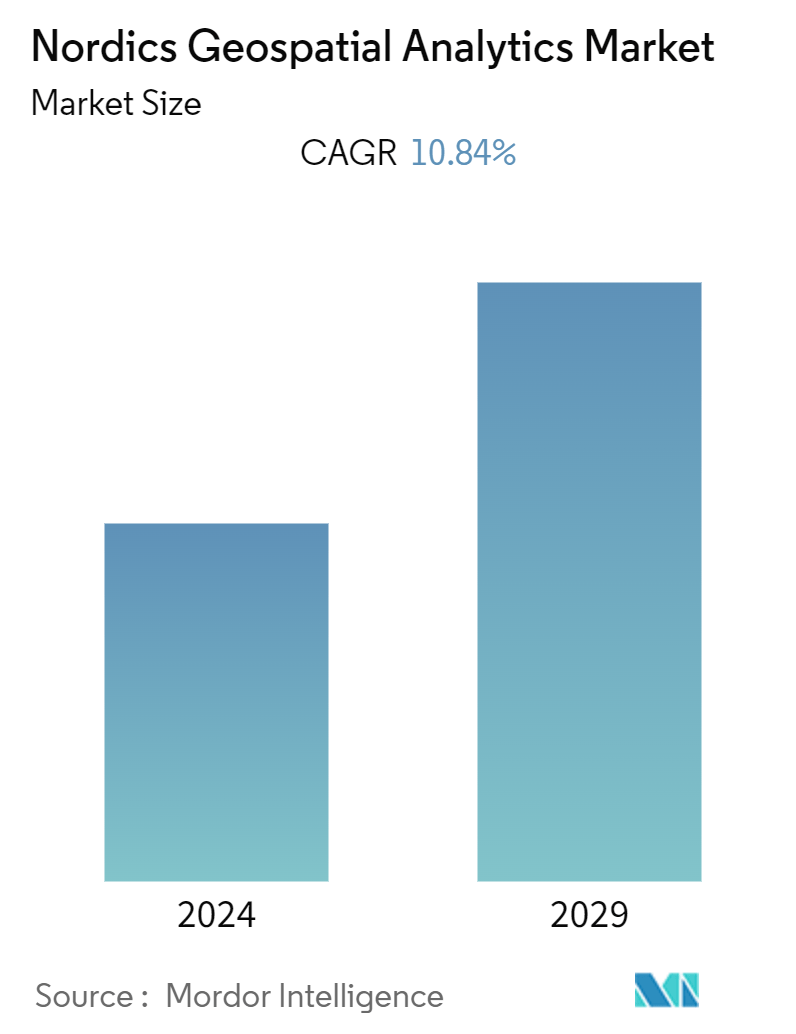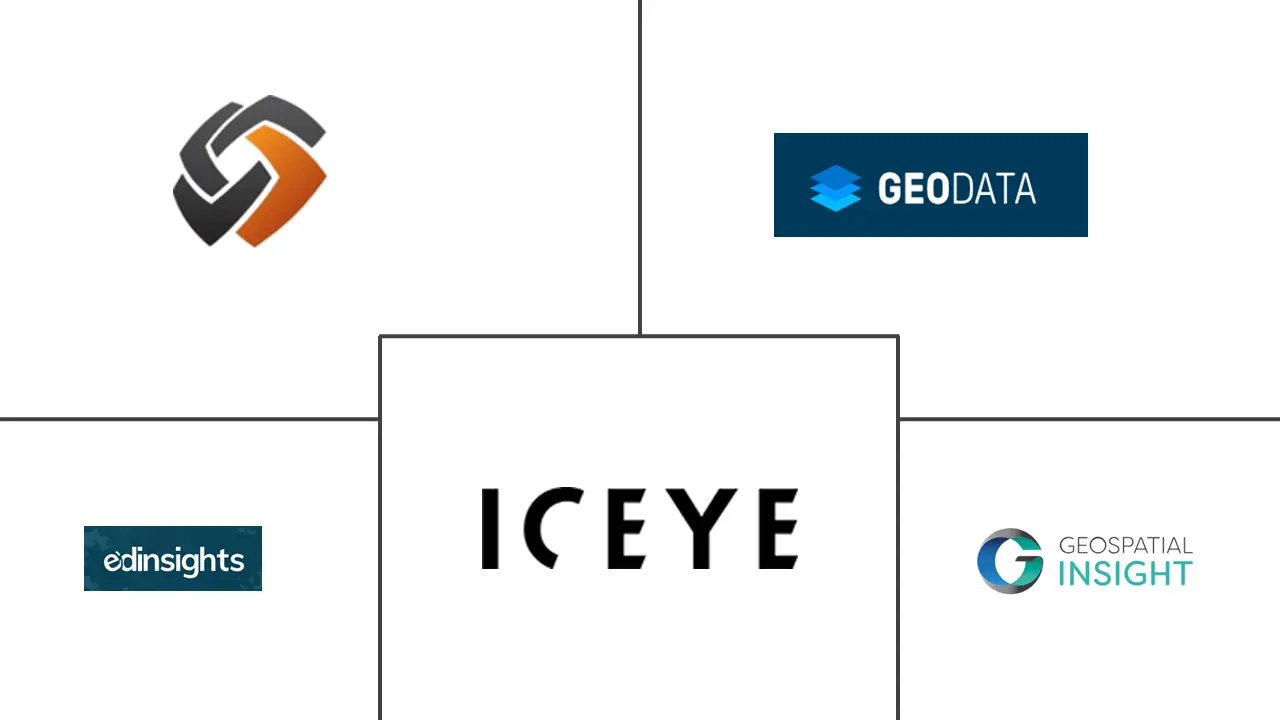Market Size of Nordics Geospatial Analytics Industry

| Study Period | 2019 - 2029 |
| Base Year For Estimation | 2023 |
| Forecast Data Period | 2024 - 2029 |
| Historical Data Period | 2019 - 2022 |
| CAGR (2024 - 2029) | 10.84 % |
| Market Concentration | Medium |
Major Players
*Disclaimer: Major Players sorted in no particular order |
Nordics Geospatial Analytics Market Analysis
The Nordics Geospatial Analytics Market is expected to register a CAGR of 10.84% during the forecast period.
The growth is majorly attributed to the significant usage of these solutions for better visualization of real-time situations in telecom, military, urban planning, and other applications.
- Geospatial analytics is acquiring, manipulating, and displaying imagery and data from the geographic information system (GIS), such as satellite photos and GPS data. The specific identifiers of a street address and a zip code are used in geospatial data analytics. They are used to create geographic models and data visualizations for more accurate trend modelling and forecasting.
- The growing smart city implementation projects in the region are one of the major driving factors for the market. For instance, despite an interruption in momentum during the pandemic, Stockholm is still on its way to becoming the world's smartest city by 2040. It's a government-declared goal in this city that aligns with the city becoming carbon neutral by 2040. Digital infrastructure, from the Internet of Things to 5G and data centres for edge processing and edge computing, will play a critical role in providing the future's services. As geospatial analytics play a crucial role in providing accurate data, the demand is analyzed to grow.
- Further, the market is driven by the increasing number of AI-based GIS solutions, advances in Big Data Analytics, the growth of smart cities, urbanization, the Internet of Things, and the integration of sensors in all sectors. Companies are able to gain increased insight through AI and machine learning capabilities in combination with spatial data.
- Combining AI and machine learning with geographical solutions saves significant time and resources. It allows the completion of tasks such as picture classification, object identification, Semantic Classification, and instance segmentation. Geospatial Analytics solution providers, as AI and ML technologies improve, may provide clients with more sophisticated Spatial solutions in several business sectors that allow them to be deployed more effectively. Therefore, these factors are analyzed to boost the market growth rate during the forecast period.
Nordics Geospatial Analytics Industry Segmentation
Geospatial Analytics adds timing and location to conventional data types and creates data visualizations. Maps, graphs, statistical data, and cartograms showing historical or current change may be included in these visualizations. A clearer picture of events is possible by means of this further context. This would allow predictions to be executed faster, simpler, and more accurately.
The Nordics geospatial analytics market is segmented by type (surface analysis, network analysis, geovisualization), end user vertical (agriculture, utility and communication, defence and intelligence, government, mining and natural resources, automotive and transportation, healthcare, real estate, and construction). The market sizes and forecasts are provided in terms of value (USD) for all the above segments.
| By Type | |
| Surface Analysis | |
| Network Analysis | |
| Geo-visualization |
| By End-user Vertical | |
| Agriculture | |
| Utility and Communication | |
| Defense and Intelligence | |
| Government | |
| Mining and Natural Resources | |
| Automotive and Transportation | |
| Healthcare | |
| Real Estate and Construction | |
| Other End-user Verticals |
Nordics Geospatial Analytics Market Size Summary
The Nordics Geospatial Analytics Market is poised for significant growth, driven by the increasing adoption of these solutions across various sectors such as telecom, military, and urban planning. Geospatial analytics, which involves the acquisition and manipulation of geographic data, is becoming essential for real-time situation visualization and trend forecasting. The rise of smart city projects in the region, particularly initiatives like Stockholm's goal to become the world's smartest city by 2040, is a major catalyst for market expansion. These projects rely heavily on digital infrastructure, including IoT, 5G, and edge computing, where geospatial analytics provide critical data support. The integration of AI and machine learning with geospatial solutions further enhances their capabilities, offering advanced spatial solutions that save time and resources while improving decision-making across various business sectors.
The market is also bolstered by the growing demand for AI-based GIS solutions and advancements in Big Data Analytics, which are integral to the development of smart cities and urbanization efforts. The telecommunications sector plays a crucial role in this growth, with companies like Tele2, Telenor, and Telia Sweden expanding 5G coverage to enhance network efficiency and address environmental challenges. The increasing urban population in the Nordics drives the real estate and construction industries to adopt advanced technologies, further fueling the demand for geospatial analytics. Strategic developments, such as investments and collaborations, are strengthening the market landscape, with companies like ICEYE and CGI leading initiatives to leverage space and geographic data technologies. These efforts aim to enhance operational effectiveness, address social challenges, and capitalize on new commercial opportunities, thereby contributing to the market's robust growth trajectory.
Nordics Geospatial Analytics Market Size - Table of Contents
-
1. MARKET INSIGHTS
-
1.1 Market Overview
-
1.2 Industry Attractiveness - Porter's Five Forces Analysis
-
1.2.1 Bargaining Power of Buyers
-
1.2.2 Bargaining Power of Suppliers
-
1.2.3 Threat of New Entrants
-
1.2.4 Threat of Substitutes
-
1.2.5 Intensity of Competitive Rivalry
-
-
1.3 Industry Value Chain Analysis
-
1.4 Macro Economic Factors having an impact on the market
-
-
2. MARKET SEGMENTATION
-
2.1 By Type
-
2.1.1 Surface Analysis
-
2.1.2 Network Analysis
-
2.1.3 Geo-visualization
-
-
2.2 By End-user Vertical
-
2.2.1 Agriculture
-
2.2.2 Utility and Communication
-
2.2.3 Defense and Intelligence
-
2.2.4 Government
-
2.2.5 Mining and Natural Resources
-
2.2.6 Automotive and Transportation
-
2.2.7 Healthcare
-
2.2.8 Real Estate and Construction
-
2.2.9 Other End-user Verticals
-
-
Nordics Geospatial Analytics Market Size FAQs
What is the current Nordics Geospatial Analytics Market size?
The Nordics Geospatial Analytics Market is projected to register a CAGR of 10.84% during the forecast period (2024-2029)
Who are the key players in Nordics Geospatial Analytics Market?
Nordic Geocenter, Geodata AS, ICEYE, Geospatial Insight and ED Insights are the major companies operating in the Nordics Geospatial Analytics Market.

